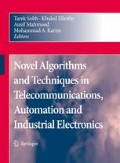Abstract
A peer-to-peer collaboration framework for multi-sensor data fusion in resource-rich radar networks is presented. In the multi-sensor data fusion, data needs to be combined in such a manner that the real-time requirement of the sensor application is met. In addition, the desired accuracy in the result of the multi-sensor fusion has to be obtained by selecting a proper set of data from multiple radar sensors. A mechanism for selecting a set of data for data fusion is provided considering application- specific needs. We also present a dynamic peer-selection algorithm, called Best Peer Selection (BPS) that chooses a set of peers based on their computation and communication capabilities to minimize the execution time required for processing data per integration algorithm. Simulation-based results show that BPS can deliver a significant improvement in execution time for multi-radar data fusion.
Access this chapter
Tax calculation will be finalised at checkout
Purchases are for personal use only
Preview
Unable to display preview. Download preview PDF.
References
McLaughlin, D.J., Chandrasekar, V., Droegemeier, K., Frasier, S., Kurose, J., Junyent, F., Philips, B., Cruz-Pol, S., and Colom, J. “Distributed Collaborative Adaptive Sensing (DCAS) for Improved Detection, Understanding, and Prediction of Atmospheric Hazards,” in Proc. of AMS IIPS for Meteorology, Oceanography, and Hydrology, American Meteorological Society (AMS), 11.3, Jan 2005
Lim, S., Chandrasekar, V., Lee, P., Jayasumana, A. P., “Reflectivity Retrieval in a Networked Radar Environment: Demonstration from the CASA IP-1 Radar Network,” Proc. of IGARSS07, Barcelona, Spain. Jul. 2007
Donovan, B., McLaughlin, D., Kurose, J. V. Chandrasekar “Principles and Design Considerations for Short-Range Energy Balanced Radar Networks”, Proc. of IGARSS05, Seoul, Korea, pp. 2058-2061, Jul. 2005
Zink, M., Westbrook, D., Abdallah, S., Horling, B., Lyons, E., Lakamraju, V., Manfredi, V., Kurose, J. and Hondl, K. “Meteorological Command and Control: An End-to-end Architecture for a Hazardous Weather Detection Sensor Network,” ACM Mobisys Workshop on End-end Sense-and-response Systems, pp. 37-42, Jun. 2005
Brotzge, K., Brewster, B., Johnson, B., Philips, M. Preston, D. Westbrook and M. Zink, “CASA’S First Test Bed: Integrative Project #1,” AMS 32nd Conf. Radar Meteor., Albuquerque, NM., 2005
BitTorrent. http:/ / www.bittorrent.com/
Gnutella. http:/ / gnutella.wego.com
Napster. http:/ / www.napster.com
Calvert L. K., Doar, M., Zegura, E., “Modeling Internet Topology”, IEEE Communications Magazine, vol. 65, no. 6, Jun. 1997. pp. 160-163
Legrand, A., Marchal, L., Casanova, H., “Scheduling Distributed Applications: the SimGrid Simulation Framework,” Proc. of CCGrid 2003. pp. 138-145, May 2003
Leland, W.E. et al., “On the Self-Similar Nature of Ethernet Traffic” IEEE/ ACM Trans. Networking, vol. 2, no. 1, 1994, pp. 1- 15
Paxson, V. “Fast, Approximate Synthesis of Fractional Gaussian Noise for Generating Self-similar Network Traffic,” Computer Communication Review, vol. 27, pp. 5-18, Oct. 1997.
Author information
Authors and Affiliations
Editor information
Editors and Affiliations
Rights and permissions
Copyright information
© 2008 Springer Science+Business Media B.V.
About this paper
Cite this paper
Lee, P., Jayasumana, A.P., Lim, S., Chandrasekar, V. (2008). A Peer-to-Peer Collaboration Framework for Multi-sensor Data Fusion. In: Sobh, T., Elleithy, K., Mahmood, A., Karim, M.A. (eds) Novel Algorithms and Techniques In Telecommunications, Automation and Industrial Electronics. Springer, Dordrecht. https://doi.org/10.1007/978-1-4020-8737-0_37
Download citation
DOI: https://doi.org/10.1007/978-1-4020-8737-0_37
Publisher Name: Springer, Dordrecht
Print ISBN: 978-1-4020-8736-3
Online ISBN: 978-1-4020-8737-0
eBook Packages: EngineeringEngineering (R0)

